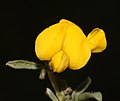Polhillia ignota
| Polhillia ignota | |
|---|---|

| |
| Scientific classification | |
| Kingdom: | Plantae |
| Clade: | Tracheophytes |
| Clade: | Angiosperms |
| Clade: | Eudicots |
| Clade: | Rosids |
| Order: | Fabales |
| Family: | Fabaceae |
| Subfamily: | Faboideae |
| Genus: | Polhillia |
| Species: | P. ignota
|
| Binomial name | |
| Polhillia ignota | |

| |
Polhillia ignota is a species of flowering plant in the genus Polhillia.[2] Prior to its rediscovery in September 2016, it was known from two specimens,[3] and declared extinct in 2014. There are only 13 plants known, on a small renosterveld fragment less than 3 ha (7.4 acres) in size.[4] It is endemic to Eendekuil, in the Western Cape.[1]
Distribution[edit]
Polhillia ignota is found from northern Swartland, between Vredenburg, Eendekuil and Porterville.[1][5]
Description[edit]
Polhillia ignota is a large, rounded shrub, up to 1 m in height. Its inflorescences are yellow.[4]
Conservation status[edit]
Polhillia ignota is classified as Critically Endangered as it occurs in critically endangered Swartland Shale Renosterveld, of which only 10% remain.[1] A single, small subpopulation of 13 plants remain in a renosterveld fragment near Eendekuil, with an EOO 4 km2 (1.5 sq mi), and an AOO of less than 4 km2 (1.5 sq mi). The population is expected to continue to decline due to ongoing threats of habitat degradation and competition from alien invasive plants.[1]
References[edit]
- ^ a b c d e "SANBI Red List of South African Plants". South African National Biodiversity Institute Threatened Species Programme. Retrieved 2022-04-16.
- ^ "Polhillia ignota Boatwr. | Plants of the World Online | Kew Science". Plants of the World Online. Retrieved 2022-04-16.
- ^ Ebrahim, Ismail; Boatwright, James Stephen; Du, Preez Brian (2017-03-01). "The rediscovery of Polhillia ignota". Veld & Flora. 103 (1): 40–41. hdl:10520/EJC-6f3813207.
- ^ a b "Polhillia ignota | PlantZAfrica". pza.sanbi.org. Retrieved 2022-04-16.
- ^ Boatwright, J. S. (2010-01-01). "A rare new species of Polhillia (Genisteae, Fabaceae)". South African Journal of Botany. 76 (1): 142–145. doi:10.1016/j.sajb.2009.07.006. hdl:11427/28211. ISSN 0254-6299.
External links[edit]
 Media related to Polhillia ignota at Wikimedia Commons
Media related to Polhillia ignota at Wikimedia Commons Data related to Polhillia ignota at Wikispecies
Data related to Polhillia ignota at Wikispecies






